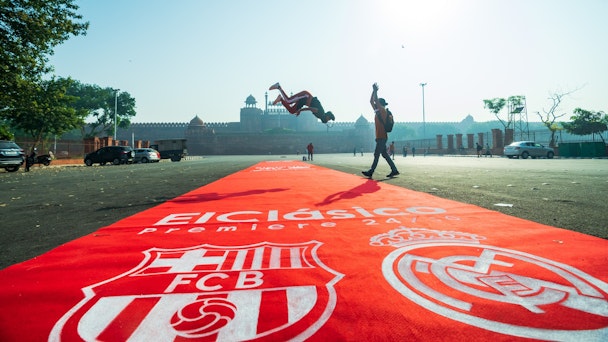As the pandemic subsides, La Liga is playing for extra time in India
Spanish football’s top tier La Liga is attempting expand its footprint in a cricket-first nation. We take a closer look at how it is recalibrating its go-to-market strategy in India, backed by experiential and on-the-ground activation.

La Liga is increasing its popularity in India
The pandemic has forced sports brands to look for new ways to connect with audiences and fans. One brand attempting to make some headway is La Liga, the top tier of men’s club football in Spain. It’s been on a busy journey in India since launching in 2016 into a market dominated by cricket.
At the beginning of its 91st season, La Liga has established itself as one of the most popular professional sports leagues in the world, and also the sixth wealthiest league by revenue. And while stadium capacity is still limited to 60%, per Spanish law, the league’s custodians are hopeful they’ll welcome back full houses before the end of the season.
For the Indian fans, this season marks a major expansion in the accessibility of matches. This year, they’ll be broadcast on the Viacom18 network, which includes MTV, Voot and Jio.
Jose Antonio Cachaza, managing director for La Liga in India (and sometime assistant referee), thinks the popularity of Spanish football can make inroads.
“It is a strategic long-term approach that we are working hard toward to establish La Liga as one of the top international sports brands in India,” he says. He’s content with its progress in just five years. “It is the number one international league in India by social media followers, with almost 6.5 million followers.”
Outplaying cricket
Though wickets and batsmanship dominate the Indian sports scene, Cachaza believes the sports media market is underdeveloped. He says: “The total revenue that professional sports generate in India, including cricket, when compared to gross GDP is still low, so there is a way for growth.”
La Liga’s plan thus far has been to market itself as an alternative, targeting female viewers. Cachaza says: “The promotion of women’s football is reaching more fans and larger TV audiences, and we can find more women attending the matches and following football in general.”
This season, women make up 45% of the total match audience, validating the gender split found through market research, he says. “Almost half of our Indian fans are women.”
While India has been working hard toward the development of its football ecosystem at every level – from grassroots to the professional league and national team – there is still a lot of work ahead and a lot of patience is needed, says Cachaza. For it to grow sustainably, football has to be inclusive as a game and as a fan experience. With local presence in mind, La Liga maintains a permanent team in India (the only football organization to do so) and hired ace cricketer Rohit Sharma as a brand ambassador.
One major on-the-ground initiative has been a school football training program that has run for four years. Before the pandemic, there were more than 4,000 boys and girls training in 14 cities across seven states. During the lockdown, La Liga tried to keep the project alive through online training and sessions.
Naturally, social plays a vital role in creating buzz and connecting with fans. During lockdown, La Liga kept fans entertained by providing unique content through social media campaign ’Stay At Home’, where players showed fans their quarantine activities and experiences.
Media moves
To help maximize its audience, La Liga recently announced an exclusive deal with Viacom18-owned flagship youth channel MTV to bring the league to the Indian market for the next three years. Both partners hope to further augment the fandom of the game through a multi-platform approach.
Cachaza concedes that it may seem to be an unusual choice, but it fits perfectly with their overall strategy of bringing La Liga closer to younger fans. For La Liga this means being more active on social media, working with YouTubers and broadcasting through Twitch.
“Even as the debate continues about whether younger fans are less prone to watching sports or not, what’s evident is that millennials and gen Z consume sports in different ways,” he says.

